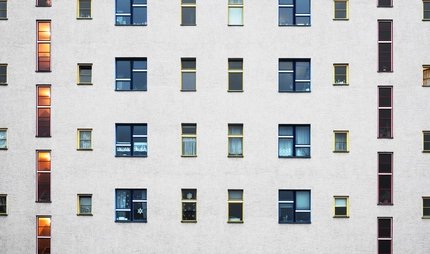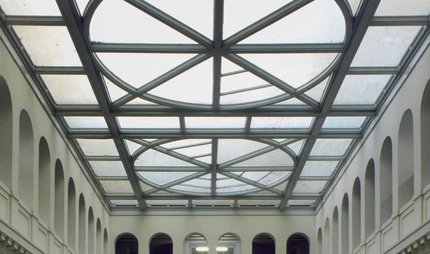
Museumswohnung WBS 70 (museum apartment)
Contemporary history close up
When you enter the Museumswohnung WBS 70, you will embark on a journey through time. Here the GDR comes to life once more.
Furniture and furnishings at Hellersdorfer Straße 179 provide authentic flair: from the upholstered green couch and the Rafena television in the living room to original GDR cookware and food items in the kitchen. Details such as wallpaper, floor coverings, décor, books and records allow visitors to immerse themselves in the everyday world of the GDR.
And the most frequently reproduced GDR work of art could not be forgotten: a print of Walter Womacka’s painting "Am Strand" hangs on the wall.
The Museumswohnung is part of a housing estate built in 1986 by the Cottbus housing combine. It not only conveys impressions of the furniture and consumer goods from this period, but is also a living testimony to the construction of the large GDR housing estate.
Prefabricated Plattenbau buildings as a solution
At the beginning of the 1970s, the GDR was suffering from a housing shortage. The government’s response was a large-scale project to build as many apartments as possible in a short time and at a reasonable cost. By 1990, every citizen was meant to have their own apartment.
The prefabricated construction method had proven itself since the end of the 1950s. Assembling precast concrete elements turned out to be cheaper and faster than steel skeleton construction and traditional masonry construction.
Initially, however, prefabricated housing also caused problems. For example, the residential building type P 2 incorporated too many special components, driving up costs. The GDR government was under pressure to streamline the prefabricated building more in order to hit its ambitious target.
Convertible success model
The architects and town planners Wilfried Stallknecht and Achim Felz were commissioned with the development of the WBS 70 (short for Wohnungsbauserie or ‘residential building series’, while the number stands for the year 1970).
Together they devised a construction method based on standardised technical and architectural principles. They designed apartments as functional units which, when combined, constituted the parts of the building.
In order to be able to build even faster, only prefabricated parts with a length of six metres were used. Since the exterior walls were to bear the weight of the building, the design of the floor plans in the WBS 70 was optional. The architects could also vary the façade by adding elements.
Convertible unlike any other prefabricated building type, the WBS 70 evolved into a popular and widespread building in the GDR, characterising the look and feel of the country.
Higher, faster – yet unsuccessful
In East Berlin in particular there was an urgent need for new apartments. With a view to Berlin’s 750th anniversary in 1987, a major construction project was launched on the outskirts of the divided city in the 1970s: in the districts of Marzahn, Hohenschönhausen and Hellersdorf, the GDR government built 91,400 new apartments in around ten years – the largest prefabricated housing estate in Europe. According to the GDR news service ADN, it usually took a city centuries to achieve such an increase in living space.
The streamlined design of the WBS 70 made this possible. An apartment like the one at Hellersdorfer Strasse 179 could be built in around 18 hours. And the rents for the WBS 70 apartments were low. A 3-room apartment of 61 square metres cost 109 Marks a month – just over ten percent of a worker’s average monthly income. This was not solely attributable to the prefabricated construction method, as rents and ancillary costs were subsidised by the state.
The apartments of the WBS 70 were highly sought-after. Each had its own bathroom, hot water and district heating – unlike the largely unmodernised Altbau buildings. After the reunification of Germany, however, their limitations became apparent: a few years after their completion, the buildings were in need of renovation. In addition, the housing market in Berlin had started offering new opportunities. Many people no longer wanted to live in a prefabricated apartment and moved out.
Conversion into a museum apartment
In 2004, the building housing the Museumswohnung WBS 70 was renovated. The municipal housing company Stadt und Land decided to preserve part of the GDR’s architectural heritage.
By carefully bringing together authentic furnishing elements, it was possible to capture the flair of this period. Wolfgang Sawatzki from Hellersdorf organises guided tours of the apartment, where he tells anecdotal stories about life in the WBS 70.

Our tips for nearby the Museumswohnung WBS 70
If you would like to find out more about creative solutions for the heritage of GDR prefabricated buildings, you should make a detour to the Ahrensfelder Terraces. To better understand the reality of life in the GDR, you can visit the Stasi Museum at Haus 1 on the former site of the Ministry of State Security. It provides information on political surveillance and persecution under the SED dictatorship.
Practical tips from visitBerlin
The best way to get to the Museumswohnung WBS 70 is by U-Bahn line 5 (direction Hönow) to the stop at Cottbusser Platz. To explore the city, we recommend the Berlin WelcomeCard for public transport.
Opening hours
| Sunday |
|---|


